Spanish Army
The Spanish Army (Spanish: Ejército de Tierra; lit. "Army of the Land/Ground") is the terrestrial army of the Spanish Armed Forces responsible for land-based military operations. It is one of the oldest active armies — dating back to the late 15th century, but we could consider a greater antiquity if we take into account that during the Visigoth Kingdom of Toledo in the sixth century with Reccared I, the territorial unity of the Kingdom was achieved, which included the entire Iberian Peninsula , thus finishing the work already begun by his father Liuvigild being the Spanish Visigoth Army in charge of defending the borders of the kingdom especially against the Franks.
| Spanish Army | |
|---|---|
| Ejército de Tierra | |
 Seal of the Spanish Army | |
| Founded | 15th century |
| Country | |
| Allegiance | King of Spain |
| Type | Army |
| Role | Land force |
| Size | 75,822 personnel (2018)[1] |
| Part of | Spanish Ministry of Defense |
| Garrison/HQ | Buenavista Palace, Madrid |
| Mascot(s) | Crowned rampant eagle with Saint James cross |
| Commanders | |
| Chief of Staff of the Army | Army General Francisco Javier Varela Salas[2] |
| Commander in Chief | King Felipe VI |
| Aircraft flown | |
| Attack helicopter | Tiger |
| Reconnaissance | MBB Bo 105 |
| Trainer | Colibrí EC135 |
| Transport | Chinook Cougar NH90 |
History
The Spanish Army has existed continuously since the reign of King Ferdinand and Queen Isabella (late 15th century). The oldest and largest of the three services, its mission was the defense of Peninsular Spain, the Balearic Islands, the Canary Islands, Melilla, Ceuta and the Spanish islands and rocks off the northern coast of Africa.
Under the Habsburgs
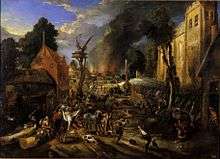
During the 16th century, Habsburg Spain saw steady growth in its military power. The Italian Wars (1494–1559) resulted in an ultimate Spanish victory and hegemony in northern Italy by expelling the French. During the war, the Spanish Army transformed its organization and tactics, evolving from a primarily pike and halberd wielding force into the first pike and shot formation of arquebusiers and pikemen, known as the columella. During the 16th century, this formation evolved into the tercio infantry formation.
Backed by the financial resources drawn from the Americas,[3] Spain fought wars against its enemies, such as the long-running Dutch Revolt (1568–1609), defending Christian Europe from Ottoman raids and invasions, supporting the Catholic cause in the French civil wars and fighting England during the Anglo-Spanish War (1585–1604). The Spanish Army grew in size from around 20,000 in the 1470s to around 300,000 by the 1630s during the Thirty Years' War that tore Europe apart, requiring the recruitment of soldiers from across Europe.[4] With such numbers involved, Spain had trouble funding the war effort on so many fronts. The non-payment of troops led to many mutinies and events such as the Sack of Antwerp (1576), in which 17,000 people died.[5]
The Thirty Years' War (1618–1648) drew in Spain alongside most other European states. Spain entered the conflict with a strong position, but the ongoing fighting gradually eroded her advantages; first Dutch, then Swedish innovations had made the tercio more vulnerable, having less flexibility and firepower than its more modern equivalents.[6] Nevertheless, Spanish armies continued to win major battles and sieges throughout this period across large swathes of Europe. French entry into the war in 1635 put additional pressure on Spain, with the French victory at the Battle of Rocroi in 1643 being a major boost for the French. By the signing of the Peace of Westphalia in 1648, Spain was forced to accept the independence of the Dutch Republic.
18th century
Spain remained an important naval and military power, depending on critical sea lanes stretching from Spain through the Caribbean and South America, and westwards towards Manila and the Far East.
The Army was reorganized on the French model and in 1704 the old Tercios were transformed into Regiments. The first modern military school (the Artillery School) was created in Segovia in 1764. Finally, in 1768 King Charles III sanctioned the "Royal Ordinances for the Regime, Discipline, Subordination, and Service in His Armies", which were in force until 1978.[7]
Napoleonic era and Restoration
In the late 18th century, Bourbon-ruled Spain had an alliance with Bourbon-ruled France and therefore did not have to fear a land war. Its only serious enemy was Britain, which had a powerful Royal Navy; Spain, therefore, concentrated its resources on its Navy. When the French Revolution overthrew the Bourbons, a land war with France became a danger which the king tried to avoid.
In Spanish Army the officer corps was selected primarily on the basis of royal patronage, rather than merit. About a third of the junior officers had been promoted from the ranks, and they did have talent, but they had few opportunities for promotion or leadership. The rank-and-file were poorly trained peasants. Elite units included foreign regiments of Irishmen, Italians, Swiss, and Walloons, in addition to elite artillery and engineering units.The army lacked its own horses, oxen, and mules for transportation, so these auxiliaries were operated by civilians, who might run away if conditions looked bad. In combat, small units fought well, but their old-fashioned tactics were hard of use against the French Grande Armée, despite repeated desperate efforts at last-minute reform.[8]
During the war, there was one victory at the Battle of Bailén within the first two months of the war and with little time to prepare against the veteran French troops, which however not followed in its advantage - the French evacuated the peninsula all the way to the Ebro valley near the Pyrenees - and suffering many humiliating defeats of the regular Spanish Army after such auspicious start, proved to be the first sound defeat to the hitherto seemly unbeatable Imperial French Army, and demonstrating that if given more or less equal forces than the usual mass superiority of the French as it happened to force the surrender of a whole division of the Imperial French Army, this inspired many other nations formerly defeated by France, motivating first Austria and showed the force of nationwide resistance to Napoleon. Conditions however steadily worsened as Napoleon brought more effective troops into the peninsula, as the insurgents increasingly took control of Spain's battle against Napoleon in guerrilla warfare and created a more or less unified underground national resistance, for which traditional armies of the time were not organized or prepared for yet. It was not the Spanish Army that defeated Napoleon, but the insurgent peasants whom Napoleon ridiculed as packs of "bandits led by monks",[9] or rebels in insurgency against the government of his brother, Joseph I, implanted by Napoleon as a new monarch. By 1812, the army controlled only scattered enclaves, and could only harass the French with occasional raids. The morale of the army had reached a nadir, and reformers stripped the aristocratic officers of most of their legal privileges.[10]
Nineteenth-century wars
.jpg)
Spain entered the 19th century with a reduction of territory and recognition of power in Europe following the Congress of Vienna in 1814 and faced renewed problems in the international arena. The Spanish military was devastated as a consequence of its former alliance with France, costing it its main fleets and many war damages in its military arsenals and weapons factories, much of which was inflicted by the British or Portuguese allies during the Peninsular campaign to prevent the French or Spanish to resume their services after the war. In the immediate aftermath of the war, while its administration was facing local rebellions against a renewed absolutist monarchy, the overseas colonies inspired by France and the United States of America sought to wrestle control from the debilitated European government that demanded more taxes to rebuild itself after the Napoleonic period disasters. Many continental armies were sent to Central America and South America which proved to be futile and too late. The former Empire lost an important artery of its power and with it the wealth in revenues which it had become dependent on over the centuries. In response, attempts were made to reform the military into a modern and standing national force, with conscription being adopted.
Spain faced a series of internal dynastic conflicts, collectively known as the Carlist Wars, requiring Spain to undergo a series of reforms directed at its military, administrative, and social structures. As consequence of these internal conflicts, and the weakness of the central structures of government under the monarchy, many generals with political ambitions would interrupt public life in multiple Coup d'états, known as Pronunciamientos, for the rest of the century until the Second Restoration of the Bourbons in Spain under Alfonso XII. These series of military interruptions in civil government eventually shaped a permissive cultural and political mentality, with a tacit expectation of "special emergency interventions" from the military that would pervade well into the first third of the 20th century. In the year 1920 the Spanish army was composed of about 500,000 men. ultimately ending up in the Spanish Civil War.
Second Republic (1931–36)
During the Second Spanish Republic, the Spanish government enlisted over ten million men to the army.
Civil War (1936–39)
Some US citizens came to Spain to fight in their civil war for two main reasons. The first being to promote their ideals and the other being to escape the trials of living in America during the great depression.
The Americans totaled 2,800 and suffered heavy casualties: 900 killed and 1,500 wounded.
The Spanish Army under the Francoist Regime (1939–1975)
This period can be divided in four phases:[11]
- 1939–1945: Second World War
- 1945–1954: International Isolation (lack of means)
- 1954–1961: Agreement with the United States (a certain improvement in means and capabilities)
- 1961–1975: Development plans (economic basis for the modernisations that follows in the 1970s and 1980s).
Second World War
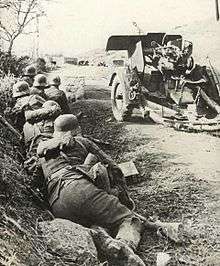
At the end of the Civil War, the Spanish (Francoist) Army counted with 1,020,500 men, in 60 Divisions.[12] During the first year of peace, Franco dramatically reduced the size of the Spanish Army to 250,000 in early 1940, with most soldiers two-year conscripts.[13] A few weeks after the end of the war, the eight traditional Military Regions (Madrid, Sevilla, Valencia, Barcelona, Zaragoza, Burgos, Valladolid, La Coruña) were reestablished. In 1944 a ninth Military Region, with HQ in Granada, was created.[12] The Air Force became an independent service, under its own Air Ministry.
Concerns about the international situation, Spain's possible entry into World War II, and threats of invasion led him to undo some of these reductions. In November 1942, with the Allied landings in North Africa and the German occupation of Vichy France bringing hostilities closer than ever to Spain's border, Franco ordered a partial mobilization, bringing the army to over 750,000 men.[13] The Air Force and Navy also grew in numbers and in budgets, to 35,000 airmen and 25,000 sailors by 1945, although for fiscal reasons Franco had to restrain attempts by both services to undertake dramatic expansions.[13]
During the Second World War, the Spanish Army had eight Army Corps, with two or three Infantry Division each. Additionally, there were two Army Corps in Northern Africa, the Canary Islands General Command and the Balearic Islands General Command, one Cavalry Division and the Artillery's General Reserve. In 1940 a Reserve Group, with three Divisions, was created.[12]
The Blue Division
Although Spanish caudillo Francisco Franco was neutral and did not bring Spain into World War II on the side of Nazi Germany, he permitted volunteers to join the German Army (Wehrmacht) on the condition they would only fight against the Soviet Union on the Eastern Front, and not against the Western Allies or any Western European occupied populations. In this manner, he could keep Spain at peace with the Western Allies, while repaying German support during the Spanish Civil War and providing an outlet for the strong anti-Communist sentiments of many Spanish nationalists. Officially designated as División Española de Voluntarios by the Spanish Army and as 250 Infanterie-Division in the German Army,The Blue Division was the only component of the German Army to be awarded a medal of their own, commissioned by Hitler in January 1944 after the Division had demonstrated its effectiveness in impeding the advance of the Red Army, on the Volkhov front (October 1941 – August 1942) and in the siege of Leningrad (August 1942 – October 1943), mainly at the battle of Krasny Bor.[14]
International Isolation
At the end of the Second World War, the Spanish Army counted 22,000 officers, 3,000 NCO and almost 300,000 soldiers. The equipment dated from the Civil War, with some systems produced in Germany during the World War. Doctrine and Training were obsolete, as they had not incorporated the teachings of the Second World War. This situation lasted until the agreements with the United States in September 1953.[11]
Agreement with the United States (Barroso Reform, 1957)
After the signature of the military agreement with the United States in 1953, the assistance received from Washington allowed Spain to procure more modern equipment and to improve the country's defence capabilities. More than 200 Spanish officers and NCOs received specialised training in the United States each year under a parallel program. With the Barroso Reform (1957), the Spanish Army abandoned the organisation inherited from the Civil War to adopt the United States' pentomic structure. In 1958 three experimental pentomic Infantry Divisions were created (Madrid, Algeciras, Valencia). In 1960, five more pentomic Infantry Divisions (Gerona, Málaga, Oviedo, Vigo, Vitoria) and four mountain Divisions were created. All in all, after the Barroso Reform, the Spanish Army had 8 pentomic Infantry Divisions, four Mountain Divisions, one Armoured Division, one Cavalry Division, three independent Armoured Brigades and three Field Artillery Brigades.[11]
Years of Economic Development (Menéndez Tolosa Reform, 1965)
The 1965 Reforms were inspired by contemporary French organisation and Doctrine of the era. The Army was grouped into two basic categories: the Immediate Intervention Forces (Field Army) and the Operational Defence Forces (Territorial Army) and were divided into the following:
- The IIF (FA) had the mission of defending the Pyrenean and the Gibraltar frontiers and of fulfilling Spain's security commitments abroad and thus were composed of the following:
- Armoured Division, with two Brigades
- Mechanised Division, with two Brigades
- Motorized Division, with two Brigades
- Parachute Brigade (raised 1973)
- Airborne Brigade
- Armored Cavalry Brigade
- Army Corps support units
- ODF (TA) units had the missions of maintaining security in the regional commands and of reinforcing the Civil Guard) and the police against subversion and terrorism categorized into:
- 9 independent TA Infantry Brigades (one in every Military Region), with two Infantry Battalions each,
- 2 TA Mountain Divisions,
- 1 Mountain Reserve of the Army High Command (TA),
- The Canary Islands, Balearic Islands, Ceuta and Melilla commands, with their respective TA units including the Regulares (6 Groups later reduced to 4) and the Spanish Legion (4 Tercios),
- and the Army General Reserve Command, composed of TA units working as the reserve force of the Army and are the equivalent to the United States Army Reserve.[11]

During the last years of the Francoist regime, contemporary weapons were ordered for the Spanish Army. In 1973, the military education system was reformed in depth, in order to make its structure and objectives similar to those existing in the civilian universities. It was during this time that the Spanish Army fought in the campaigns in what is now Western Sahara against Arab forces in the area who agitated for the end of Spanish colonial rule.
The Spanish Army under King Juan Carlos I and beyond
Initial years (1975–1989)
Three main events characterise this period: creation of a single Ministry of Defence (1977) to replace the three existing military ministries (Army, Navy and Air Ministries), the failed coup d'état in February 1981 and the accession to NATO in 1982.
The Army modernisation program (META plan) was done between 1982 and 1988 in order for Spain to achieve full compliance with NATO standards.[15] When the plan was completed the following results were achieved:
- Military regions in the mainland were reduced from 9 to 6.
- The IIF (FA) and the ODF (TA) were merged into one single structure.
- The number of Brigades was reduced from 24 to 15.
- Personnel numbers were reduced from 279,000 to 230,000.
After the end of the Cold War (1989–present)
The end of the Cold War came with the reduction of the term of military service for conscripts until its complete abolition in 2001[16] and the increasing participation of Spanish forces in multinational peacekeeping operations abroad[17] are the main drivers for changes in the Spanish Army after 1989. Three reorganisation plans were implemented since: the RETO plan (1990), the NORTE plan (1994)[18] and the Instruction for Organisation and Operation of the Army (IOFET) 2005.
Today
Personnel

In 2001, when compulsory military service was still in effect, the army was about 135,000 troops (50,000 officers and 86,000 soldiers). Following the suspension of conscription the Spanish Army became a fully professionalised volunteer force and by 2008 had a personnel strength of 75,000.[19] In case of a war or national emergency, an additional force of 80,000 Civil Guards comes under the Ministry of Defence command.
Equipment
Weapons
- Heckler & Koch USP - 9 mm pistol. Standard issue pistol
- Heckler & Koch MP5 - 9 mm submachine gun. Used by Special Operations Forces.
- Heckler & Koch G36E - 5.56 mm assault rifle. Standard Issue Rifle. Without integral red dot sight, Spanish variants use a Picatinny Rail to mount an EoTech holographic sight
- Heckler & Koch G36KE and G36CE - 5.56 mm Carbines. Used by Special Operations Forces.
- Heckler & Koch HK417 - 7.62 mm NATO battle rifle. Used by Special Operations Forces.
- CETME rifle - 7.62 NATO battle rifle. Largely phased out and replaced by HK G36
- Rheinmetall MG3 - 7.62 mm NATO medium machine gun
- Heckler & Koch MG4 - 5.56 mm light machine gun (standard LMG)
- Browning M2 HB - 12.70 mm heavy machine gun
- SB LAG 40 grenade Launcher
- Instalaza Alhambra-DO hand grenade
- Instalaza C-100 Alcotán - 100 mm anti-tank rocket launcher
- Instalaza C-90 CR (M3) - 90 mm disposable anti-tank rocket launcher
- Spike - anti-tank missile launcher
- Milan - anti-tank missile launcher
- TOW 2 - anti-tank missile launcher
- Barrett M95 - 12.7 mm heavy sniper rifle
- Accuracy International Arctic Warfare - 7.62 mm sniper rifle
- ECIA L65/60 60 mm light mortar
- ECIA L65/81 mortar - 81 mm medium mortar
- ECIA L65/105 mortar - 105 mm medium mortar
- ECIA L65/120 mortar - 120 mm heavy mortar
Combat vehicles
- 219 Leopardo 2E (A6) Main Battle Tank
- 108 Leopard 2 A4 Main Battle Tank ( 54 in reserve )
- 261 Pizarro infantry fighting vehicles in two versions
- 500+ M113 armored personnel carriers in seven versions
- 90 TOM Bv206S tracked vehicle
- 84 VRC-105B1 Centauro wheeled tank-destroyer
- 4 VCREC Centauro
- 648 BMR-M1 medium six-wheeled APC
- 135 VEC-M1 cavalry scout vehicle
- 185 IVECO LMV Lince 4WD tactical vehicle (575 total order)
- 100 RG-31 Mk5E Nyala (MRAP) 4WD tactical vehicle (MRAP)
- 10 Cardom Recoil Mortar System (RMS)
- 6 Husky 2G (mine detection system)
- URO VAMTAC, all terrain 4x4 tactical vehicle (more than 1,500)
- Santana Anibal, an all terrain 4x4 utility vehicle (more than 1,500)
- Iveco Euro Cargo all terrain utility vehicle
- Volvo FH
- Iveco M250W.37
- VEMPAR Tactic Heavy Lorry 450HP, 20t cargo lorry
Artillery
- M109A5 - 155/39 mm self-propelled howitzer, as the M109A5(+96)
- 155/52 APU SBT - 155/52 mm howitzer (84)
- L-118A1 - 105/37 mm light field howitzer (56) with Base Bleed (range 21 km) by Expal
- OERLIKON GDF-005 35/90 35 mm Anti-aircraft artillery piece (92)
- Raytheon MIM-104 Patriot - Surface-to-Air missile system (3 batteries)
- Skyguard-Aspide - Surface-to-Air missile system (13)
- NASAMS - Surface-to-Air missile system (8)
- MBDA SATCP Mistral missile - Anti-aircraft infrared homing missile system (168)
Aircraft
| Type | Origin | Class | Role | Introduced | In service | Total | Notes |
|---|---|---|---|---|---|---|---|
| Agusta-Bell 212 | Italy | Rotorcraft | Utility | 6 | |||
| Boeing CH-47D Chinook | USA | Rotorcraft | Transport | 17 | To be upgraded to CH-47F by Boeing in 2019.[20] | ||
| Eurocopter AS332B1 Super Puma | France | Rotorcraft | Transport | 1982 | 16 | ||
| Eurocopter AS532UL Cougar | France | Rotorcraft | Transport | 1998 | 17 | ||
| Eurocopter EC-135 | Europe | Rotorcraft | Trainer/utility | 2008 | 16 | ||
| Eurocopter Tiger | Europe | Rotorcraft | Attack | 2007 | 20 | 4 on order | |
| NHI NH90 | Europe | Rotorcraft | Transport | 2016 | 8 | 37 on order |
Unmanned aerial vehicles
- 4 x INTA SIVA
- 4 x IAI Searcher MK II J
- 47 x RQ-11 Raven (mini UAV)
- 6 x 2 Atlantic and 4 Tucan
Formation and structure
Commanders in Chief of the Spanish Army
Army Ministers
Source: es:Ministerio del Ejército
- Lieutenant General José Enrique Varela Iglesias (1939–1942)
- Lieutenant General Carlos Asensio Cabanillas (1942–1945)
- Lieutenant General Fidel Dávila Arrondo (1945–1951)
- Lieutenant General Agustín Muñoz Grandes (1951–1957)
- Lieutenant General Antonio Barroso y Sánchez-Guerra (1957–1962)
- Lieutenant General Pablo Martín Alonso (1962–1964)
- Lieutenant General Camilo Menéndez Tolosa (1964–1969)
- Lieutenant General Juan Castañón de Mena (1969–1973)
- Lieutenant General Francisco Coloma Gallegos (1973–1975)
- Lieutenant General Félix Álvarez-Arenas y Pacheco (1975–1977)
Chiefs of the Army Staff

- Lieutenant General José Vega Rodríguez (1976–1978)[21]
- Lieutenant General Tomás de Liniers y Pidal (1978–1979)[21]
- Lieutenant General José Gabeiras Montero (1979–1982)[21]
- Lieutenant General Ramón de Ascanio y Togores (1982–1984)[21]
- Lieutenant General José María Sáenz de Tejada y Fernández de Bobadilla (1984–1986)[21]
- Lieutenant General Miguel Íñiguez del Moral (1986–1990)[21]
- Lieutenant General Ramón Porgueres Hernández (1990–1994)[21]
- Lieutenant General José Faura Martín (1994–1998)[21]
- Lieutenant General Alfonso Pardo de Santayana y Coloma (1998–2003)[21]
- Army General Luis Alejandre Sintes (2003–2004)[21]
- Army General José Antonio García González (2004–2006)[21]
- Army General Carlos Villar Turrau (2006–2008)[21]
- Army General Fulgencio Coll Bucher (2008–2012)[21]
- Army General Jaime Domínguez Buj (2012–2017)[22]
- Army General Francisco Javier Varela Salas (2017–present)[2]
Uniforms
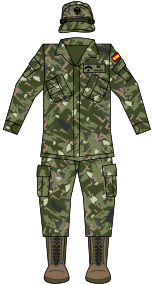 |
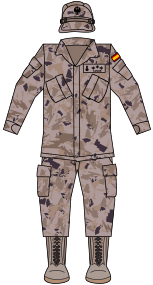 |
Ranks and insignia
The military ranks of the Spanish army are as follows below. For a comparison with other NATO ranks see Ranks and Insignia of NATO. Ranks are wore on the cuff, sleeves and shoulders of all army uniforms, but differ by the type of the uniform being used.
| NATO code | OF-10 | OF-9 | OF-8 | OF-7 | OF-6 | OF-5 | OF-4 | OF-3 | OF-2 | OF-1 | OF(D) | Student officer | ||||||||||||||||||||||||
|---|---|---|---|---|---|---|---|---|---|---|---|---|---|---|---|---|---|---|---|---|---|---|---|---|---|---|---|---|---|---|---|---|---|---|---|---|
(Edit) |
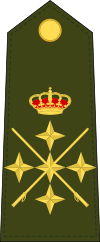 |
 |
 |
 |
 |
 |
 |
 |
 |
 |
 |
 |
 |
 |
 | |||||||||||||||||||||
| Capitán general[note 1] | General de Ejército | Teniente general | General de división | General de brigada | Coronel | Teniente coronel | Comandante | Capitán | Teniente | Alférez | Caballero Alférez Cadete | Alumno repetidor | Alumno 2º | Alumno 1º | ||||||||||||||||||||||
| ||||||||||||||||||||||||||||||||||||
| NATO Code | OR-9 | OR-8 | OR-7 | OR-6 | OR-5 | OR-4 | OR-3 | OR-2 | OR-1 | |||||||||||||||||||||||||||
|---|---|---|---|---|---|---|---|---|---|---|---|---|---|---|---|---|---|---|---|---|---|---|---|---|---|---|---|---|---|---|---|---|---|---|---|---|
(Edit) |
 |
 |
 |
 |
 |
 |
 |
 |
 |
 | ||||||||||||||||||||||||||
| Suboficial mayor | Subteniente | Brigada | Sargento primero | Sargento | Cabo mayor | Cabo primero | Cabo | Soldado de primera | Soldado | |||||||||||||||||||||||||||
See also
- Spanish Armed Forces
- Army of Spain (Peninsular War)
- NATO
- FAMET
- Spanish legion
- Regulares
- Spanish Republican Army
- Coats of Arms, Badges and Emblems of the Spanish Army
References
- "España Hoy 2016-2016". lamoncloa.gob.es (in Spanish). Archived from the original on 10 May 2017. Retrieved 27 May 2017.
- New chiefs of Army, Navy and Air Force. Archived 31 March 2017 at the Wayback Machine Ministry of Defence (Spain). Retrieved 31 March 2017
- Elton, p. 181.
- Anderson, p. 17.
- Carlton, 2011: p.42.
- Meade, p. 180.
- "Comparative Atlas of Defence in Latin America / 2008 Edition, p.42 (PDF)" (PDF). resdal.org. Archived (PDF) from the original on 24 December 2018. Retrieved 30 April 2018.
- Charles J. Esdaile, The Spanish Army in the Peninsular War (1988)
- Russell Crandall (2014). America's Dirty Wars: Irregular Warfare from 1776 to the War on Terror. Cambridge UP. p. 21. Archived from the original on 30 November 2015. Retrieved 2 July 2015.
- Otto Pivka, Spanish Armies of the Napoleonic Wars (Osprey Men-at-Arms, 1975)
- PUELL DE LA VILLA, Fernando (2010). "El devenir del Ejército de Tierra (1945-1975)". In Fernando Puell de la Vega y Sonia Alda Mejías (ed.). Los Ejércitos del franquismo. Madrid: IUGM-UNED. 2010. Pp. 63-96.
- MUÑOZ BOLAÑOS, Roberto (2010). "La institución militar en la posguerra (1939-1945)". In Fernando Puell de la Vega y Sonia Alda Mejías (ed.). Los Ejércitos del franquismo. Madrid: IUGM-UNED. 2010. Pp. 15-55.
- Bowen, Wayne H.; José E. Álvarez (2007). A Military History of Modern Spain. Greenwood Publishing Group. p. 114. ISBN 978-0-275-99357-3. Archived from the original on 5 May 2016. Retrieved 2 July 2015.
- Luca de Tena, Torcuato (1976). Embajador en el infierno (Ambassador to Hell). Barcelona: Editorial Planeta. pp. 15–22. ISBN 84-320-2152-0.
- YÁRNOZ, Carlos (10 February 1983). "El plan de modernización del Ejército de Tierra renovará completamente la estructura actual". elpais.com. Archived from the original on 3 April 2015. Retrieved 31 December 2013.
- See an announcement by the Minister of Defence Archived 6 January 2014 at the Wayback Machine
- "Archived copy". Archived from the original on 4 January 2014. Retrieved 4 January 2014.CS1 maint: archived copy as title (link)
- CERVERA ARTEAGA, Eva. "Retrospectiva de tres décadas en el Ejército de Tierra español". Archived from the original on 6 January 2014. Retrieved 31 December 2013.
- "Estadística de Personal Militar de Complemento , Militar Profesional de Tropa y Marinería y Reservista Voluntario (PDF)" (PDF). mde.es. Archived from the original (PDF) on 26 December 2011. Retrieved 30 April 2018.
- Waldron, Greg (4 January 2019). "Boeing to upgrade Spain CH-47D fleet to -F standard". Flight Global. Singapore. Archived from the original on 23 January 2019. Retrieved 4 January 2019.
- La transformación de los ejércitos españoles (1975-2008). Madrid: UNED. 2009. p. 366.
- "Real Decreto 1164/2012, de 27 de julio (PDF)" (PDF). boe.es. Archived (PDF) from the original on 4 March 2016. Retrieved 30 April 2018.
- The King only
Bibliography
- Instruction no. 59/2005, of 4 April 2005, from the chief of the army staff on army organisation and function regulations, published in B.O.D. NO. 80 of 26 April 2005
- Lehardy, Diego, Spanish Army in a difficult phase of its transformation, RID magazine, July 1991.
External links and further reading
| Wikimedia Commons has media related to Army of Spain. |
- Home page of the Spanish Land Army (in English)
- Recruitment page (in Spanish)
- The Spanish Military Forum